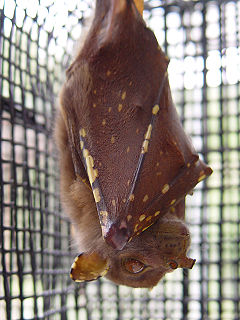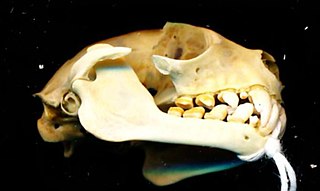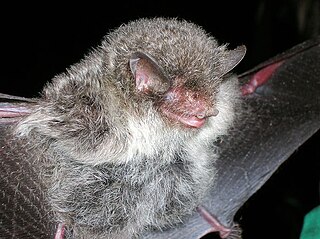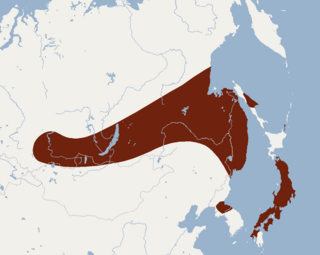
Vespertilionidae is a family of microbats, of the order Chiroptera, flying, insect-eating mammals variously described as the common, vesper, or simple nosed bats. The vespertilionid family is the most diverse and widely distributed of bat families, specialised in many forms to occupy a range of habitats and ecological circumstances, and it is frequently observed or the subject of research. The facial features of the species are often simple, as they mainly rely on vocally emitted echolocation. The tails of the species are enclosed by the lower flight membranes between the legs. Over 300 species are distributed all over the world, on every continent except Antarctica. It owes its name to the genus Vespertilio, which takes its name from a word for bat, vespertilio, derived from the Latin term vesper meaning 'evening'; they are termed as evening bats and once referred to as 'evening birds'.

The eastern or Queensland tube-nosed bat is a megabat in the family Pteropodidae that lives in north-eastern Australia. N. robinsoni is one of the few species in Pteropodidae that roosts solitarily. They get their common name from their raised tubular nostrils which is unlike most other species in the family. They are a deep brown with gray heads and sparse yellow spotting.

The flute-nosed bat is a vespertilionid bat with an unusually shaped nose, the tubular nostrils facing outward from the end of the muzzle. They occur in the north of the Australian state of Queensland, in Indonesia, and on Papua New Guinea.
The eastern false pipistrelle, species Falsistrellus tasmaniensis, is a vespertilionid bat that occurs in eastern and south-eastern Australia, including the island of Tasmania.

Sorensen's leaf-nosed bat is a species of bat in the family Hipposideridae that is endemic to Indonesia.

The broad-striped tube-nosed fruit bat, also known as the greater tube-nosed bat is a species of megabat in the genus Nyctimene. It is found in West Papua, Indonesia, Papua New Guinea, and central Philippines. In 1912, Andersen distinguished it by its very broad dorsal stripe on the center of its back. Although this species is believed to exist at low densities, the IUCN estimates its population to be stable and has no major threats to its continued existence. The IUCN classifies Nyctimene celaenoThomas, 1922 as a synonym of this species, however as of 2013 the ITIS lists it as a separate species.

Pallas's tube-nosed bat, also known as the Torresian tube-nosed bat or northern tube-nosed bat, is a species of megabat in the Nyctimene genus found in Indonesia. Its range may extend to New Guinea, but sightings may be attributable to misidentification. Its range may at one time also have extended to Timor, but was extirpated due to habitat loss.

The round-eared tube-nosed fruit bat is a species of bat in the family Pteropodidae. It is possibly conspecific with Nyctimene certans, although the taxonomy remains unresolved. The possible synonymy of the species was investigated by Randolph L. Peterson in 1991, finding the species split into two distinct groups based on morphology. It is found in West Papua and Mansuar Island in Indonesia.

The dragon tube-nosed fruit bat is a species of bat in the family Pteropodidae. It is found on both sides of New Guinea: West Papua, Indonesia and Papua New Guinea. It is slightly smaller and very similar in appearance to N. albiventer, differing by having more profuse, dark spotting on its wing membranes, and smaller shorter canines. The similarity between the species has been a source of possible misidentifications. The records of this species from Papua New Guinea are associated with freshwater swamps and rivers.

The demonic tube-nosed fruit bat is a species of bat in the family Pteropodidae. It is endemic to Papua New Guinea. The holotype specimen was collected in 1979 on New Ireland, in the Bismarck Archipelago. It was described as a new species in 1983. The range of the species may extend to other islands, however the extent of the range is not presently known.

The lesser tube-nosed bat is a species of megabat in the family Pteropodidae. It is native to two of the Maluku Islands in northern Indonesia.

The Philippine tube-nosed fruit bat locally known in Tagalog as Bayakan is a species of bat in the family Pteropodidae. It is endemic to the Philippines and known from the islands of Cebu, Negros and Sibuyan. It occurs in and near primary and secondary subtropical or tropical dry forests. It is often found near water. It is threatened by habitat loss due to deforestation. The species is named for Dioscoro S. Rabor who, with several others, first collected the species.

The lesser tube-nosed fruit bat or unstriped tube-nosed bat is a species of megabat in the family Pteropodidae found in West Papua, Indonesia and Papua New Guinea.

Peters's tube-nosed bat is a species of vesper bat in the family Vespertilionidae, found in the Indian Subcontinent, mainly in the Western Himalayas. They have tube-shaped nostrils which assist them with their feeding. They are brown with white-yellow and underparts and have specks of orange around their neck. While they are roosting, their fur, which seems to appear as a dead plant, camouflages them from predators. They are 3.3-6.0 cm in length and have round heads, large eyes and soft fur. This bat is found in India. They are endangered due to clearing of the rain forests in which they live in and are not protected by the World Conservation Union. They feed on rain forest fruit and blossoms.

The Murininae are a subfamily of bats in the family Vespertilionidae. They include the tube-nosed bats and hairy-winged bats in the genera Murina, Harpiola, and Harpiocephalus.

The steadfast tube-nosed fruit bat is a species of megabat in the family Pteropodidae found in West Papua, Indonesia, and Papua New Guinea.

Hilgendorf's tube-nosed bat is a species of vesper bat in the family Vespertilionidae. In Japan they are called 'tengu komori', after the mythical creature called the Tengu. It was formerly thought to be a subspecies of Murina leucogaster, but is now known to be a distinct species.
The Formosan golden tube-nosed bat is native to the high-altitude regions of Taiwan.















